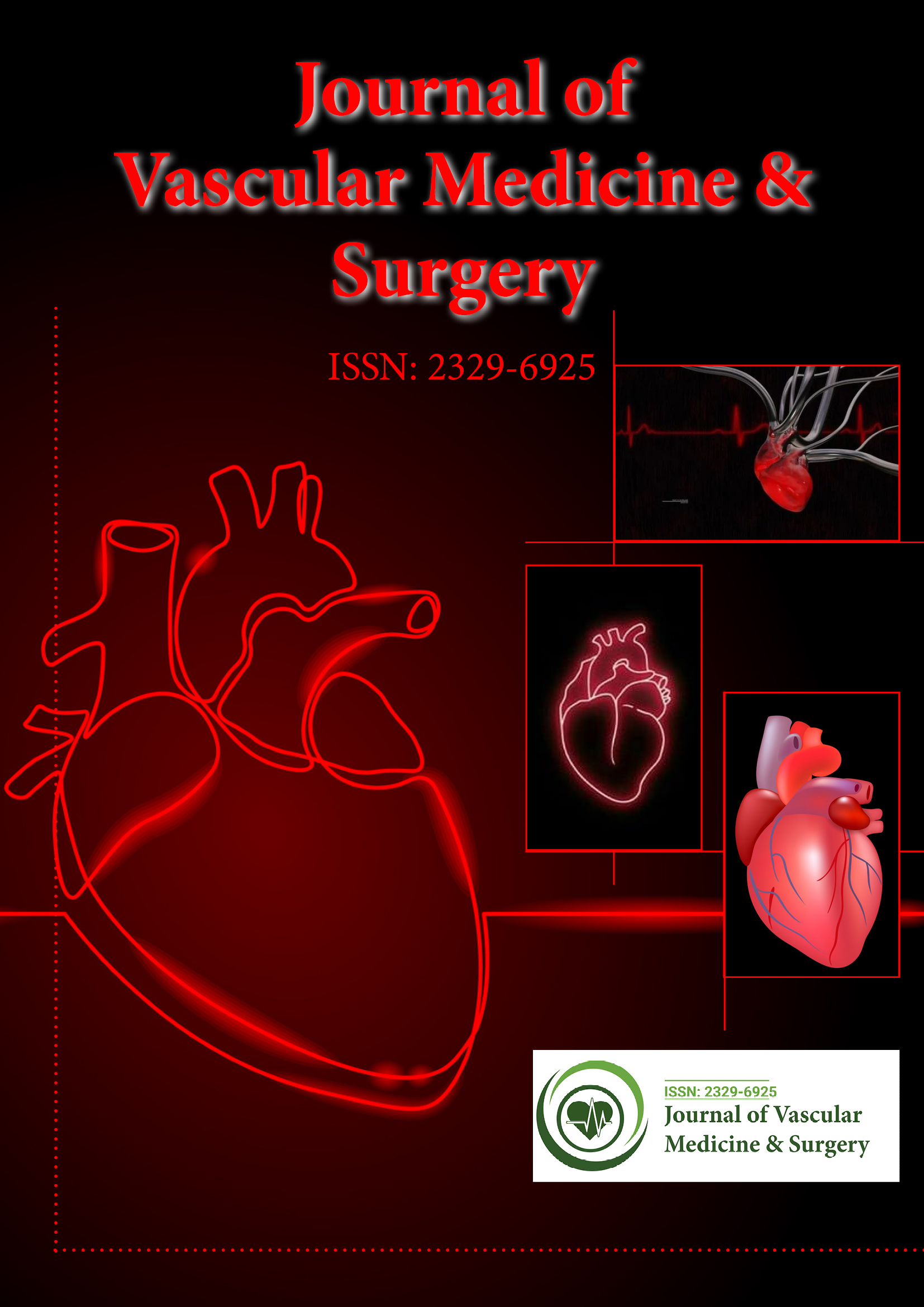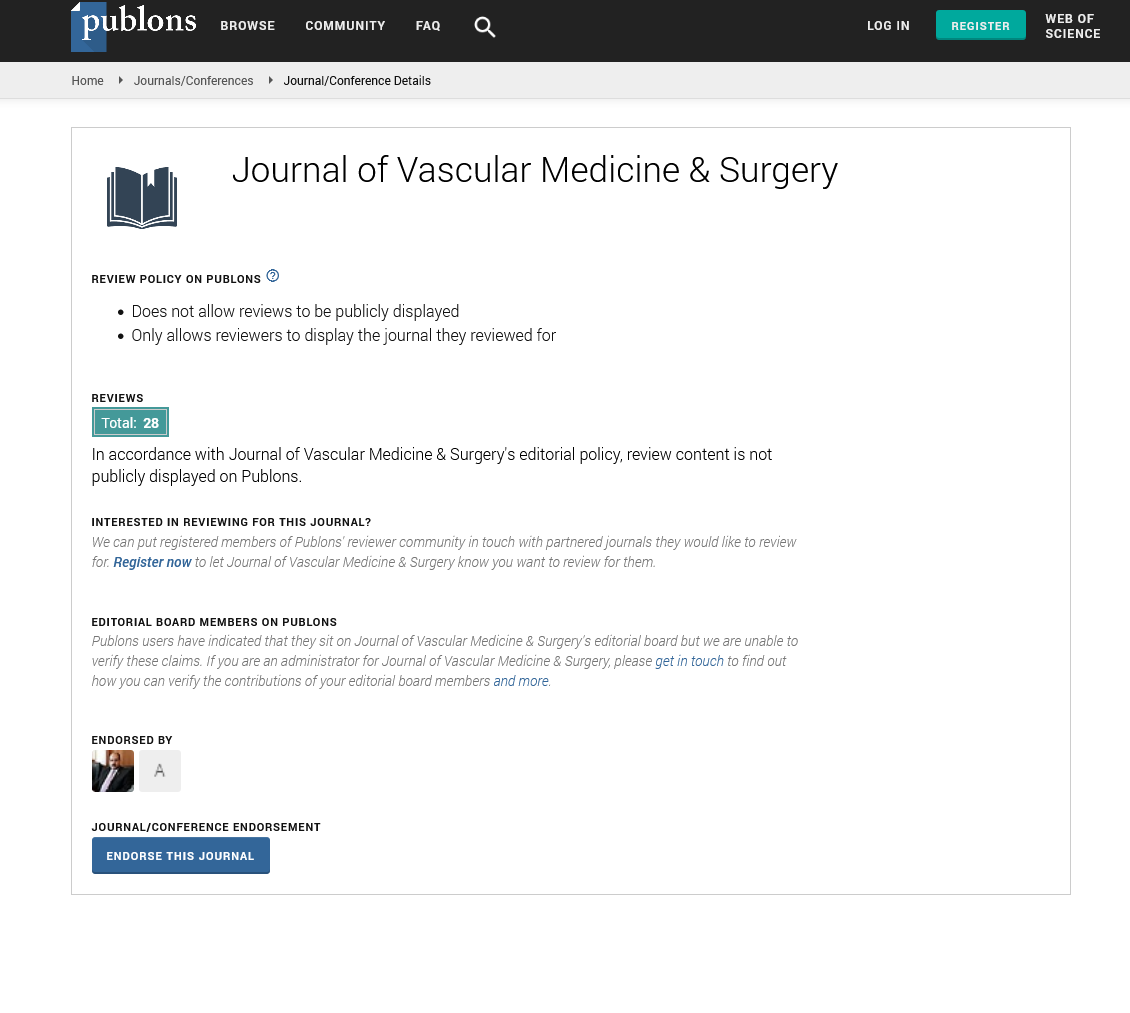Indexed In
- Open J Gate
- Academic Keys
- RefSeek
- Hamdard University
- EBSCO A-Z
- OCLC- WorldCat
- Publons
- Euro Pub
- Google Scholar
- SHERPA ROMEO
Useful Links
Share This Page
Journal Flyer

Open Access Journals
- Agri and Aquaculture
- Biochemistry
- Bioinformatics & Systems Biology
- Business & Management
- Chemistry
- Clinical Sciences
- Engineering
- Food & Nutrition
- General Science
- Genetics & Molecular Biology
- Immunology & Microbiology
- Medical Sciences
- Neuroscience & Psychology
- Nursing & Health Care
- Pharmaceutical Sciences
Commentary - (2021) Volume 9, Issue 5
Small-Diameter Artificial Vascular Grafts
Takashi Tanaka* and Ryo TanakaReceived: 08-Sep-2021 Published: 29-Sep-2021, DOI: 10.35248/2329-6925.21.9.427
Description
Cardiovascular diseases, including coronary heart disease, cerebrovascular disease, peripheral artery disease, and deep vein thrombosis, cause blockage or stenosis of blood vessels due to decreased blood flow or tissue damage due to improper nutrition [1]. The annual incidence of deaths associated with these diseases is predicted to reach 23.3 million worldwide by 2030 [2]. Treatment of cardiovascular diseases varies from diet and lifestyle improvement to drug treatment and surgical intervention, depending on the severity of the disease [3]. Surgical treatments can be divided into endovascular surgery using stents and catheters and bypass surgery. Intravascular surgery has been performed in recent years due to advances in technology and low invasiveness to patients; however, due to problems such as high cost and limitations on the location and size of the affected area, the demand for bypass surgery remains high [4].
Autologous vascular grafts and artificial vascular grafts are used for bypass surgery. However, no artificial vascular grafts are currently clinically applied in small-diameter sites (<5 mm), such as coronary arteries and popliteal arteries. Therefore, autologous vascular grafts are mainly used when performing bypass surgery in those sites. Autologous vascular grafts mainly use the internal sternum artery, radial artery, and saphenous vein removed from the patient. However many restrictions, such as poor blood vessel quality among donor patients, invasion by excision surgery, and postoperative movement restriction, still exist. At present, commercially available useful artificial vascular grafts are limited to a diameter of >5 mm. In cases where a small-diameter graft is necessary for bypass surgeries lower limbs or coronary arteries, commercial artificial vascular graft materials may be occluded by thrombosis or intimal hyperplasia [5]. Therefore, development of a small-diameter artificial vascular graft having high patency is desired.
Tissue Engineering Vascular Graft
Thrombus formation, intimal hyperplasia, atherosclerosis, and infection are some causes of obstruction of small-diameter artificial vascular grafts. It is considered that long-term patency can be enhanced by preventing the formation of thrombi that occurs early after implantation. However, attempts to prevent thrombus adhesion with hydrophobic materials, such as expanded Polytetrafluoroethylene (e-PTFE), work well for medium-diameter sites (6 mm-8 mm), but not for small-diameter sites.
Small-diameter grafts must meet various requirements to maintain long-term functionality. For that purpose, these grafts need to have biocompatibility with surrounding tissues and adjacent autologous blood vessels, in small-diameter sites. Because commercial artificial vascular graft materials may be occluded by thrombosis or intimal hyperplasia in cases where small-diameter sites. Artificial vascular grafts so as not to induce thrombosis, and at the same time have appropriate mechanical strength and elasticity to withstand systolic blood pressure. However, small-diameter artificial vascular grafts made by Dacron and e-PTFE, which are used in large-and mediumdiameter vessels, have resulted in thrombus formation and intima hyperplasia due to the lack of vascular endothelial cells and inconsistency with autologous blood vessels.
For decades, active research has been ongoing on small-diameter artificial vascular grafts using tissue engineering that promote remodeling into self-tissue. The usefulness of artificial vascular grafts prepared by seeding vascular endothelial cells into advance and artificial vascular grafts, called biotube, has been reported, but it takes time to prepare them [6,7]. In addition, biotube has not been put into practical use because long-term storage is impossible. Decellularized scaffolds have been developed to obtain artificial blood vessels that mimic natural blood vessels in both structural and biomechanical performances, while avoiding harmful immune responses [8]. However, inadequate decellularization led to adverse immune reactions and implant failure in some cases. Therefore, no prediction can be made on the viability of this approach. Small-diameter artificial vascular grafts composed of degradable synthetic materials, such as polyglycolic acid, poly-L-lactic acid, and polycaprolactone gave good experimental results, but these grafts have not reached clinical application due to thrombosis and biocompatibility inconsistencies [9].
In recent years, many artificial vascular grafts created with electrospinning and 3D bio printing techniques have shown good implantation results. However, whether they can achieve the required mechanical strength for use in the circulatory system remains to be seen [10,11]. Natural biopolymers, such as elastin and silk, have better cell compatibility, biocompatibility, and mechanical properties. A Silk Fibroin (SF) (1.5 mm) graft implanted in a rat abdominal aorta showed higher patency (85%) for up to 1 year than that observed for e-PTFE (30%) [12]. Although improvements are being made in SF artificial vascular grafts, many of them are based on implantation results in small animal models; therefore, implantation results in larger animals are required in the future.
Conclusion
Many different approaches have been used to create smalldiameter artificial vascular grafts and many different experimental results have been reported, but the best solution has not yet been identified. Effective artificial grafting involves selecting the most appropriate cell types to be used in smalldiameter vascular grafts and determining how to maintain the required graft mechanical properties and most appropriate animal models for evaluations of grafts. In addition, there are some problems that need to be solved in order to use this approach immediately in clinical practice. These problems include the abundance of size and length of small-diameter artificial vascular grafts, whether they can be stored for long periods, and whether they are economically acceptable. It is hoped that various research groups will continue to aim for clinical application of small-diameter artificial blood vessels while solving each of these problems using various methods and technologies.
REFERENCES
- Pashneh-Tala S, MacNeil S, Claeyssens F. The tissue-engineered vascular graft-past, present, and future. Tissue Eng Part B-Re. 2016; 22 (1): 68-100.
- Mathers CD, Loncar D. Projections of global mortality and burden of disease from 2002 to 2030. Plos Med. 2006; 3 (11): e442.
- Abdulhannan P, Russell DA, Homer-Vanniasinkam S. Peripheral arterial disease: A literature review. Brit Med Bull. 2012; 104 (1): 21-39.
- Antoniou GA, Chalmers N, Georgiadis GS, Lazarides MK, Antoniou SA, Serracino-Inglott F, et al. A meta-analysis of endovascular versus surgical reconstruction of femoropopliteal arterial disease. J Vasc Surg. 2013; 57 (1): 242-253.
- Tatterton M, Wilshaw SP, Ingham E, Homer-Vanniasinkam S. The use of antithrombotic therapies in reducing synthetic small-diameter vascular graft thrombosis. Vasc Endovasc Surg. 2012; 46 (3): 212-222.
- Laube HR, Duwe J, Rutsch W, Konertz W. Clinical experience with autologous endothelial cellâ??seeded polytetrafluoroethylene coronary artery bypass grafts. J Thorac Cardiov Sur. 2000; 120 (1): 134-141.
- Ma N, Wang Z, Chen H, Sun Y, Hong H, Sun Q, et al. Development of the novel biotube inserting technique for acceleration of thick-walled autologous tissue-engineered vascular grafts fabrication. J Mater Sci-Mater M. 2011; 22 (4): 1037-1043.
- Mahara A, Somekawa S, Kobayashi N, Hirano Y, Kimura Y, Fujisato T, et al. Tissue-engineered acellular small diameter long-bypass grafts with neointima-inducing activity. Biomaterials. 2015; 58: 54-62.
- Obiweluozor FO, Emechebe GA, Kim DW, Cho HJ, Park CH, Kim CS, et al. Considerations in the development of small-diameter vascular graft as an alternative for bypass and reconstructive surgeries: A review. Cardiovasc Eng Techn. 2020; 18: 1-27.
- Bergmeister H, Schreiber C, Grasl C, Walter I, Plasenzotti R, Stoiber M, et al. Healing characteristics of electrospun polyurethane grafts with various porosities. Acta Biomater. 2013; 9 (4): 6032-6040.
- Kim SH, Yeon YK, Lee JM, Chao JR, Lee YJ, Seo YB, et al. Precisely printable and biocompatible silk fibroin bioink for digital light processing 3D printing. Nat Commun. 2018; 9 (1): 1-4.
- Enomoto S, Sumi M, Kajimoto K, Nakazawa Y, Takahashi R, Takabayashi C, et al. Long-term patency of small-diameter vascular graft made from fibroin, a silk-based biodegradable material. J Vasc Surg. 2010; 51 (1): 155-164.
Citation: Tanaka T, Tanaka R(2021) Small-Diameter Artificial Vascular Grafts. J Vasc Med Surg. 9:427.
Copyright: © 2021 Tanaka T, et al. This is an open-access article distributed under the terms of the Creative Commons Attribution License, which permits unrestricted use, distribution, and reproduction in any medium, provided the original author and source are credited.

